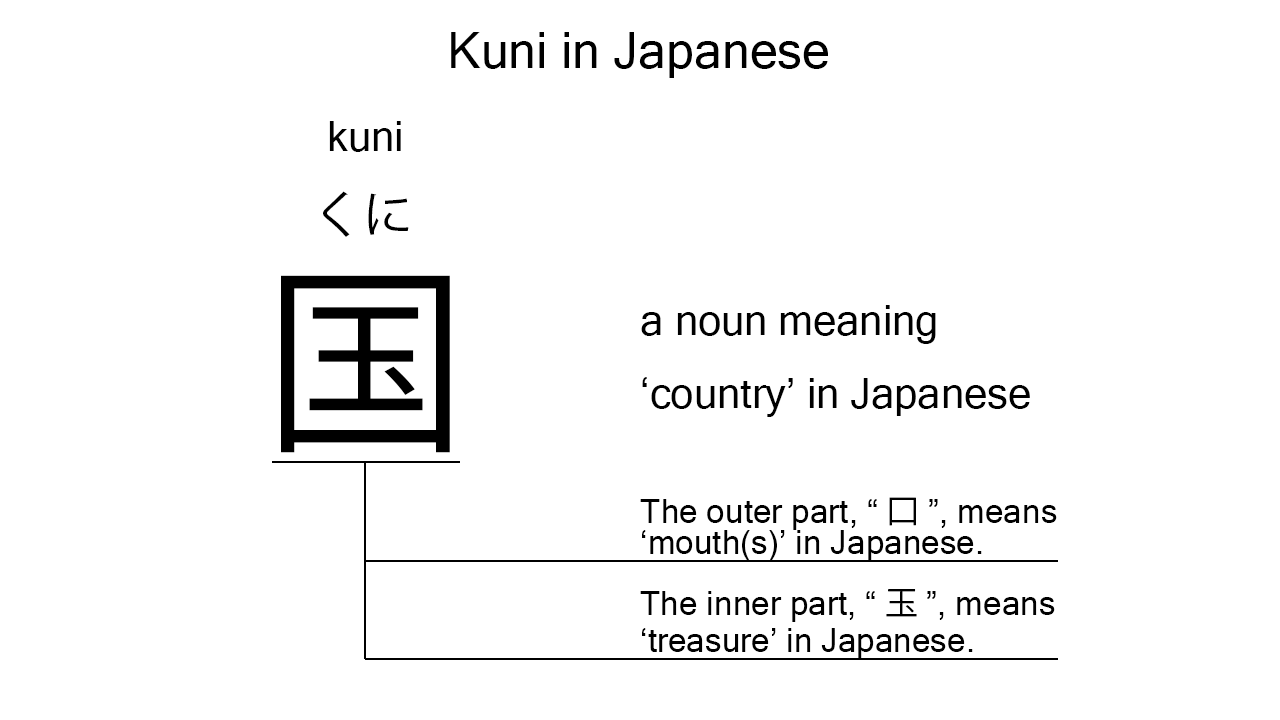What does “kuni” mean in Japanese?
Native speakers say “kuni” to mean ‘country’ in Japanese. Perhaps, some Japanese learners know this word as it is sometimes used in Japanese textbooks. In this blog post, however, I will explain this word in detail based on its kanji character. And also, I will explain how to use it through example sentences. My explanations would help Japanese learners understand “kuni” more clearly. Then, let’s get started!
Contents
Definition and meaning of “kuni”
Let me start with the definition and meaning of “kuni”.
- kuni – 国 (くに) : a noun meaning ‘country’ in Japanese. This can also work as plural. Learn more about Japanese plural.
The definition and meaning are simple and clear. To understand this noun more clearly, however, let me explain its kanji character in detail.
What does “kuni” literally mean in Japanese?
The kanji character of “kuni” consists of the following two parts:
- 口 : a kanji character widely used to mean ‘mouth’ in Japanese.
- 玉 : a kanji character used to mean ‘treasure’ in Japanese.
From these two parts, we can understand that “kuni” literally means a ‘mouth and treasure’ in Japanese. This literal interpretation is not in line with the actual meaning, but represents well what a country is like. A country can be considered as something holding its treasure inside. So, these two parts work as a good metaphor.

When we meet new kanji characters, we should check their parts in detail to understand their meanings clearly and deeply. In many cases, kanji parts tell us a lot about the meanings of the characters they form. Actually, here, we could get the better understanding of “kuni” through the detailed check above.
So far, I’ve explained the definition and meaning of “kuni” together with its kanji parts. Then, let me explain how to use it through the example sentences below.
Example #1: how to say “country” in Japanese
kanojo wa tōi kuni ni it ta – 彼女は遠い国に行った (かのじょはとおいくににいった)
She has gone to a far country.
Below are the new words used in the example sentence.
- kanojo – 彼女 (かのじょ) : a pronoun meaning ‘she’ in Japanese.
- wa – は : a binding particle working as a case marker or topic marker. In the example, this works after “kanojo” to make the subject in the sentence.
- tōi – 遠い (とおい) : an i-adjective meaning ‘far’ in Japanese.
- ni – に : a case particle used to say where someone or something goes. In the example, this is used after “tōi kuni” to say where she has gone.
- it – 行っ (いっ) : one conjugation of the verb, “iku“, which means ‘to go’ in Japanese. In the example, it has been conjugated for the better connection with its following word.
- ta – た : an auxiliary verb used after a verb, adjective, or auxiliary verb to make its past tense form. Probably, this is well known as a part of Japanese ta form. In the example, this is used after “it” to make its past tense form, “it ta”.
This is a typical usage of “kuni”. In this example, it works together with “tōi” to mean a ‘far country’ in Japanese. When we want to mean a ‘country’ or ‘countries’ in Japanese, anyway, this noun is always a very good option.
Example #2: another usage of “kuni”
mahou no kuni de kare ni at ta – 魔法の国で彼に会った (まほうのくにでかれにあった)
I met him in a magical country.
Below are the new words used in the example sentence.
- mahou – 魔法 (まほう) : a noun meaning ‘magic’ in Japanese.
- no – の : a case particle joining two nouns. Normally, the first one can work as a modifier to describe the second. In the example, this works to join “mahou” and “kuni”. The formed phrase literally means a ‘magical country’ in Japanese.
- de – で : a case particle used to say where someone does something. In the example, this is used after “mahou no kuni” to say where the speaker met him.
- kare – 彼 (かれ) : a pronoun meaning ‘he’ in Japanese.
- ni – に : a case particle used to say to whom an action is directed. In the example, this is used after “kare” to say to whom the action described by “at ta” is directed.
- at – 会っ (あっ) : one conjugation of the verb, “au”, which means ‘to meet’, ‘to see’, or such in Japanese. In the example, it has been conjugated for the better connection with its following word.
This is another typical usage of “kuni”. In this example, it works as a part of the noun phrase to mean a ‘magical country’ in Japanese. It’s worth mentioning here that “kuni” is often used together with the case particle, “no”, to say “a country of blah blah” or “a blah blah country” in Japanese.
Summary
In this blog post, I’ve explained the definition and meaning of “kuni” in detail based on its kanji character. And also, I’ve explained how to use it through the example sentences. Let me summarize them as follows.
- kuni – 国 (くに) : a noun meaning ‘country’ in Japanese. This can also work as plural. The inner part of this kanji character means ‘treasure’ in Japanese; the outer part means a ‘mouth’. So, this kanji is a metaphor for something holding its treasure inside. When we want to mean a ‘country’ or ‘countries’ in Japanese, this noun is always a very good option.
Hope my explanations are understandable and helpful for Japanese learners.